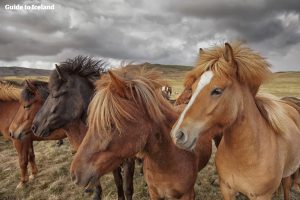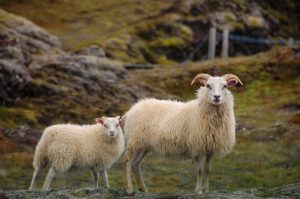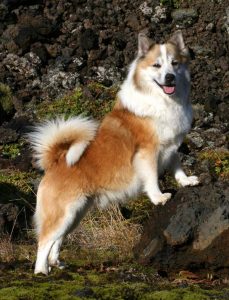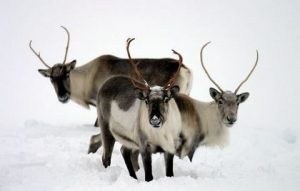The species of animals that have lived in Iceland since the settlement in 874 are unchanged do to the isolation of the country and there for law and regulations concerning the import of domestic animals and pets are very strict and to the point. Before the settlers came to Iceland there were few animals already in the island; they were foxes and many kinds of birds.
Foxes– The fox, Alopex lagopus were the only wild mammal in Iceland when the settlers arrived from Norway. The fox has been living in Iceland ever since the ice age. The fox is very well adjusted to the polar zone. The fox shed’s during the spring and in the fall. In the winter the fox’s fur turns snow-white, but in the summer the back of the fox and the outer limbs turn gray-brown, the belly and the inside of the limbs turn light-gray. Geese and waders are the main food sources of the fox. The foxes live widely in Iceland, but mostly on the highlands and by the sea. Burrows can be found in little holes under rocks, in large manors or in soil ground.
Icelandic horses – The Icelandic horse is mainly from Western-Norway, Northern-Britain and Hebrides island. Everyone that was on their way to Iceland during the settlement took their horse with them. The horse was used to carry fertilizer and get people to places. The carriage wasn’t there until the 20 century. The horses live for about 35-40 years. The time of pregnancy is 11 months. Icelandic horses come in 100 colours. The Icelandic horses have sleek, glossy coats during the warm months, but develop a furry, thick winter coats for the cold winter. The Icelandic horse hasn’t been blended with other breeds through the ages.
The young horses are first ridden at the age four. The initial training takes about two months. Then the young horse is allowed to roam free for one year before the training continues.
The five gates of Icelandic horses:
- Walk is an even four beat cadence, moving each foot independently.
- Trot is a two beat gait, with the front and back legs on opposite sides moving together.
- Canter, a three beat gait, also called gallop.
- Tölt or running walk is an amazingly smooth four beat travelling gait, where all four feet move in the same pattern as in the walk with more action and speed. This is unique gate that the Icelandic horse has.
- The flying pace is a two beat gait, where front and hind legs on the same side move forward and back at the same time.
Cows – The first cows came with the settlers from Norway, but also from Britain. During the 19th century, cattle was imported from Denmark to mix breeds with the cows from Norway, but the look of the cows didn’t change much. The amount of cattle in Iceland is about 70.000, amongst them are about 25.000 cows who produce milk.
Icelandic sheep – the sheep was brought here by the early Viking settlers in the 9th and 10th century. It is now illegal to import any sheep to Iceland. The sheep itself is genetically the same today as it was 1100 years ago.
The Icelandic sheep are medium size and weight around 68-73 kg. and the ram about 91-100 kg. They mature early and the ewes can easily lamb at 12 months of age. Ram lambs can start breeding around seven months old. The Icelandic sheep’s is known for their wool. Which is in two layered. The skin of the Icelandic sheep is excellent as a pelt skin. It’s mainly because how dense the wool is. Fashion clothing, mostly coats, have been made from the pelts. The skins are also sold as sheepskin rugs.
Pigs – The pigs were brought to Iceland with the settlers. The main purpose of the pig’s cultivation was to make sure that the people would get the most, and the best meat from each pig. Many people eat a smoked pig’s meat for supper during the Christmas season.
Goat – the Icelandic male sheep are usually around 60 kg and the female 45 kg. The time of pregnancy is 5 months. The usually have 1-2 baby goats. We can get wool, meat, milk and horns out of the goats. Goats have a long history in Iceland. They arrived with the first settlers, just like the cows, horses and sheep. But today there are only about 200 goats left in Iceland. A good Icelandic goat can milk about 200-300 liters per year.
Icelandic sheepdog – The Icelandic sheepdog is Iceland’s only native dog. The Nordic settlers, who started arriving in 874 before Christ, brought it to the country.
The Icelandic sheepdog is a medium sized dog with pricked ears and curled tail. The dog can have several colors, from all shades of tan to reddish brown, grey, white and black. In 1969, a group of Icelanders were concerned because the Icelandic sheepdog was in danger of extinction. This led to the founding the Icelandic Sheepdog Breed Club in 1979 and since then it has been responsible for upholding and developing the breed. The Icelandic sheepdog’s popularity has increased over the decades and it is no longer in danger of extinction. The Icelandic sheepdog is a valuable part of the county’s heritage, a treasure which must be safeguarded for the future.
Cats – The Icelandic cat can get about 2-4 kg. The time of pregnancy is about 60 days. These cats can have about 3-5 kittens each time. The Icelandic cat has accompanied us from the settlement. The Icelandic breed hasn’t changed much over the years but it has blended with cats that have been imported. In the old days the cats job was to keep the rats and mice away from the homes.
Hens – Like most other animals, the hen came with the settlers to Iceland about 1100 years ago. In Iceland, it’s very popular to have hens in the backyard. There’s also a lot of hen cultivation over the country. The active population of the Icelandic hen is low. An organization was created in the year 2003 to protect the Icelandic hen; to keep the breed pure, healthy and colorful.
Mink– Mustela vison and mustela lutreola. The kind mustela vison lives in Northern- America. Mustela lutreola lives in selected places in Europe. The first mink arrived to the country in the fall of 1931, they were hunted in Northern- America. The main reason the mink was transferred to Iceland was to create fur bearing animal farms, to research and study them. The mink was transferred to a place in Iceland called Grímsnes. Mink farms were created to note mink feeding. About a year later, the mink escaped and started living wild in the nature. The mink eats about any kind of fish, birds, invertebrates, and mice.
Reindeers – Reindeer are the largest land mammals in Iceland. They were imported to Iceland from North-Norway in the late 18th century. The purpose of importation was to enrich the fauna (wildlife) in Iceland. The deer stands out from other animals because the both sexes are angular. They have thick coat that is airy and protects them from the cold. The time of pregnancy is about seven and half months. The calves are born during a three week period that begins May. The calves grow very rapidly in the first few weeks because they drink loads of milk.
There are about 5200 reindeers in Iceland and the only live in the east and southeast area. You can often see reindeer herds in this particular area.
Reindeer hunting is allowed in Iceland, but to do so you have to have the licence. Reindeer hunting is one of the most expensive sports in Iceland. Every year the reindeers are counted and quotas are determined by population. Issued licenses are usually about 1,200 per year. The hunting season is from 1 August to 20 September.
Rabbits – The rabbits arrived in Iceland around the year 1930. Many rabbits escaped farming and fertilized in the nature. In the capital area, and on the small island called Vestmannaeyjar, are a lot of rabbits living wild in the nature. Because of the climate change, it is easier for the rabbits to live in the nature. Rabbits are also common pets.
Written by Adisa and Hildur Ósk
Presentations about Icelandic animals
References:
Ásta Stefánsdóttir. 2012. “Landnámshænan” Eigenda- og ræktendafélag landnámshænsna. Sótt af 16.09.2016: http://www.haena.is/landnamshanan/
Birgir Sumarliðason, Friðrik Haraldsson, Guðmundur Guðjónsson og Jón Lárusson. e.d. “ÍSLENZKU HÚSDÝRIN. NAT. Sótt af 05.09.2016: http://www.nat.is
Carwardine, Mark. (1998). Hvalir við Ísland. [Íslensk þýðing Ari Trausti Guðmundsson.] Reykjavík; Vaka- Helgafell hf.
Guttormur Sigbjarnarson og Páll Hersteinsson. (1993). Villt íslensk spendýr. Reykjavík; Steinholt hf.
Númi Steinn Möller Hallgrímsson og Sindri Smárason. 2013. “Hvernig og hvenær komu kanínur til Íslands?” Vísindavefurinn. Sótt af 19.09.2016: http://www.visindavefur.is/svar.php?id=61300
Án höf. 2009. “Íslenska kýrin”. Erfðanefnd landbúnaðarins. Sótt af 07.09.2016: http://agrogen.lbhi.is/pages/1235
Án höf. e.d. “Íslensku svínin” Íslensku húsdýrin. Sótt af 07.09.2016: http://alfheidur.weebly.com/iacuteslenska-sviacutenieth.html





